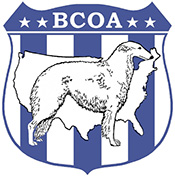
![[ Random Borzoi Image ]](../bannerpicsrandom/image-74.jpg)

![[ Random Borzoi Image ]](../bannerpicsrandom/image-74.jpg)
Borzoi are entered in conformation shows by their owners for many purposes: to receive evaluations from licensed judges, to compete for an American Kennel Club championship, to improve the breed by comparing entered animals to the written Standard as potential breeding stock, and to present our best representatives of the breed to an interested public.
Each year there are thousands of competitive events for dogs held under the rules of the America Kennel Club. There are dog shows and performance events (obedience and rally obedience trials, lure coursing trials, tracking tests, and agility trials). Within each category there are formal licensed events ("point shows" at which championship points or credit toward performance titles may be earned) and informal events ("match shows" or "matches" at which no points or credit towards titles are earned, but at which dogs and owners gain experience and confidence). There are also events sanctioned by non-AKC organizations, such as the Large Gazehound Racing Association or the American Sighthound Field Association lure coursing trials. These and other activities for you and your Borzoi are the subject of other Borzoi Club of America pamphlets.
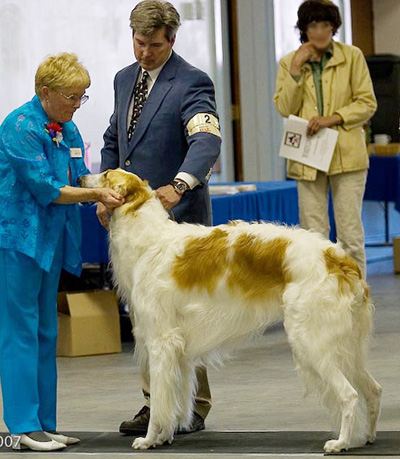
At dog shows held under America Kennel Club rules, conformation is stressed. Judges licensed by the America Kennel Club examine the entered Borzoi and place them in order according to how close, in the judge's opinion, the dog conforms to the ideal as described in the Borzoi Club of America's standard for the breed, as currently accepted by the America Kennel Club. Each dog is judged on physical structure, appearance, condition, gait (as seen from the front, side and rear) and temperament. (The Borzoi standard is shown on the Borzoi Standard page of this site, or the AKC Web Site, or in The Complete Dog Book, published by the American Kennel Club, 5580 Centerview Drive, Raleigh NC 27606-3390.)
There are two types of conformation shows; specialty shows put on by individual breed clubs (such as the Borzoi Club of America and other local or regional Borzoi clubs) and all-breed shows held by all-breed clubs (examples being the numerous local kennel clubs).
Judging at a conformation show is a process of elimination that ultimately results in one dog being selected as Best of Breed. At an all-breed show, further eliminations result in one dog being selected Best In Show.
Dogs entered in competition at conformation shows are competing for points toward their conformation championship. To become an official American Kennel Club conformation champion a dog must earn 15 points. Points are based upon the number of dogs in actual competition - the more dogs, the more points, up to a maximum of five points at any one show. The number of dogs required for points varies with its sex and the geographical location of the show, according to a schedule annually set up by the America Kennel Club to help equalize competition from area to area. For example, a large number of Borzoi entries in one area of the country will result in more dogs being required for points in that region. See the AKC's Conformation Point Schedule.
A dog can earn up to five points at a show. Single wins of three, four or five points are termed "majors." The 15 points required for an American Kennel Club conformation championship must be won under at least three different judges and must include a minimum of two majors won under different judges. There are seven regular classes in which dogs seeking points compete (dogs competing for points are frequently referred to as "class dogs" or "class bitches" while dogs already champions compete only in Best of Breed competition and are referred to as "specials," either dog or bitch). These classes are:
(1) Puppy: for dogs between 6 months and under 12 months of age that are not champions. The dog's age is calculated up to and inclusive of the first day of a show. The class may be divided in 6-to-9 month and 9-to-12 month divisions.
(2) Twelve-To-Eighteen Month: for dogs between 12 months and under 18 months that are not champions. The dog's age is calculated up to and inclusive of the first day of a show.
(3) Novice: for dogs six months of age and over, which, prior to the closing date of entries, have not won three First prizes in Novice Class, a First prize in Bred-By-Exhibitor, American-Bred or Open Classes, or one or more points towards their championship.
(4) Amateur-Owner-Handler: for dogs that are at least six months of age that are not champions. Dogs must be handled in the class by the registered owner of the dog and is limited to exhibitors who have not, at any point in time, been a professional dog handler, AKC approved conformation judge, or employed as an assistant to a professional handler. (effective January 1, 2009)
(5) Bred-By-Exhibitor: shall be for dogs that are:
(a) Six months of age of older as of the first day of the show
(b) Not Champions of record on the date of closing of entries for the show,
(c) Individually registered with the American Kennel Club as of the date of closing of entries for the show,
(d) Owned or co-owned by any of the breeders of record as of the date of the closing of entries for the show. The person handling the dog in this class must be a breeder of record and an owner of record of this dog.
In any subsequent classes for which the dog from the Bred-By Exhibitor class becomes eligible, there are no restrictions as to who may handle. (Effective September 18, 2002)
(6) American-Bred: for all dogs, except champions, six months of age and over, whelped in the United States, by reason of a mating which took place in the United States.
(7) Open: for any dog six months of age or over, except in a member specialty club show held only for American-bred dogs, in which case the Open Class shall be only for American-bred dogs.
Enter your Borzoi in the class for which it is qualified and best suited.
Only one male and one female can win points at each show. There is no inter-sex competition in the above classes. Dogs (males) compete against other dogs. Bitches (females) compete against other bitches. All dog classes are judged first, then all bitch classes.
Judging begins with Puppy dog class. In each class, the dogs are evaluated and the top four are awarded First, Second, Third, and Fourth placements. Only the first place winner in each class remains in competition for the points; the others are eliminated. After the judge has judged Puppy Dogs, Twelve-To-Eighteen Month Dog, Novice Dog, Bred-By-Exhibitor Dog, American-Bred Dog and Open dogs, the winners (first placers) from each class are brought back into the ring to compete against each other in the Winners Class.
Winners Class shall be open only to undefeated dogs of the same sex which have won first prizes in either Puppy 6-9 months, Puppy 9-12 months, Twelve-To-Eighteen Month, Novice, Bred-By-Exhibitor, American-Bred, or Open classes.
The dog selected best is the Winners Dog. He is the male who receives the points at this show. Following the selection of the Winners Dog, the dog that placed second to him in his original class of competition is brought back into the ring to compete with the other class winners for Reserve Winners Dog. In other words, the dog defeated only by the Winners Dog will be awarded Reserve Winners Dog. The Reserve will receive the points if for any reason the Winner's win is disallowed by the American Kennel Club.
The same process is repeated in the bitch competition with a Winners Bitch, the only bitch to receive points, and a Reserve Winners Bitch being selected.
The judge now judges one more class in which there are five awards. This class is for Best of Breed.
Best of Breed competition has in it all dogs and bitches that are Champions of Record and dogs and bitches which, according to the owners' records, have completed the requirements for a championship but whose championships are unconfirmed, as well as the Winners Dog and the Winners Bitch. In addition, any other undefeated dogs or bitches that competed at the show in additional non-regular classes shall also compete for the Best of Breed award. Examples of non-regular classes are the Veteran Dog and Veteran Bitch classes found at Specialty shows.
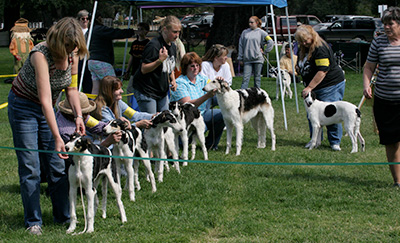
The judge evaluates all of the animals entered and selects one as Best of Breed. If the dog designated Winners Dog or Winners Bitch is awarded Best of Breed, the dogs of both sexes that have been entered and competed for Best of Breed competition and that have been defeated in that competition, shall be counted, in addition to those already defeated in the regular classes for it sex, in calculating championship points. Then, between the Winners Dog and the Winners Bitch, the judge selects a Best of Winners. If either the Winners Dog or Winners Bitch is selected Best of Breed, it automatically becomes Best of Winners. The dog awarded the Best of Winners shall be credited with the number of points calculated for Winners Dog or Winners Bitch, whichever is greater. The judge next selects the Best of Opposite Sex to the Best of Breed. If the Best of Breed is a dog, the Best of Opposite Sex must be a bitch; while if the Best of Breed is a bitch, the Best of Opposite Sex must be awarded to a dog. The judge finishes by awarding Select Dog and Select Bitch to one of each gender of the remaining champions of record. These individuals will be credited with Grand Championship points calculated by adding all the class animals and champions of its sex, excluding the Best of Breed and Best of Opposite Sex winners. (See AKC's Explanation of Grand Champions)
If the dog designated Winners Dog or Winners Bitch is also awarded Best of Opposite Sex to the Best of Breed, the dogs of its own sex that have been entered and competed for the Best of Breed and defeated in the competition for Best of Opposite Sex are counted, in addition to those already defeated in the regular classes for it sex, in calculating championship points.
At an all-breed show the same process of elimination takes place in every breed entered. All dogs designated as Best of Breed then compete in one of the seven groups. The Borzoi competes in the Hound Group. Four placements are awarded in each group. The first place winners are brought into the ring and Best In Show is selected. This dog alone at the end of the day is undefeated. A Reserve Best in Show award is given to the second placing dog from this final grouping.
In counting the number of eligible dogs in competition, a dog that is disqualified, dismissed, excused or ordered from the ring by the judge, or from which all awards are withheld, shall not be included. Remember, that just because a dog is listed in the catalog doesn't mean that they are included; absentees do not count either.
"Tear sheets," copies of the pages in the judges' books, are available for exhibitor review to check entries, points, placements, etc., at the superintendent's table. It may be useful to compare the tear sheets against your personal marked catalog for accuracy. You can track your dog's points on-line at the AKC website in your personal account.
Each Borzoi entered in a conformation show should be presented to its best advantage: well-groomed and in good condition; to be otherwise is an insult to the judge and the breed. Condition starts with good quality dog food, fresh water, plenty of exercise, freedom from internal and external parasites and general good health.
Grooming should be a pleasurable experience for your dog and you. If you start brushing and nail trimming on puppies at an early age and giving lots of praise, your Borzoi will find the time spent being groomed a pleasure to which he looks forward.
There is an endless array of grooming equipment available. To start out, a basic set of equipment should include a pin brush, steel comb, heavy-duty nail clippers, straight scissors and thinning sheers. (The higher the number on thinning shears, the more teeth and less hair removed.) Eventually you may find many other useful pieces of equipment that may work for your particular needs.
Heavy tartar build up must be removed by a veterinarian with a cavitron for which your dog will have to anesthetized. Better to avoid that by regular brushing.
Removal of the whiskers is optional. If you choose to remove whiskers use a blunt tip scissors. Your may find it helpful to position a finger inside the lip under the whisker(s) before you cut, as this will leave less stubble. Cut as close as possible without cutting any surrounding coat. Whisker removal is done at the time of bathing, just before the show.
No amount of trimming can change a dog's structure, which is one of the elements that an American Kennel Club licensed judge will evaluate a dog on at a conformation show. However, if moderately, tastefully and properly done, trimming can enhance a Borzoi's appearance. Conversely, be aware that excessive trimming or a poorly done trimming job may adversely affect a dog's appearance in the conformation show ring. Therefore, trim in moderation, being aware of the potential positive and negative impact it may have on your dog's appearance.
Basic dental hygiene and bathing as well as nail trimming are always in order before a show.
A Borzoi should not be scissored like a terrier. It should look natural. If you elect to trim your Borzoi, any trimming should be done slowly and at least two weeks before the show to prevent a freshly trimmed look. Remember, you can always remove a little more, but you can't replace what you've already removed.
The ears are one of the hardest areas to trim and yet retain the natural look. Use the thinning shears to remove the hair that sticks up and out in front of the ear opening and ear edges, being careful not to give a shaved look. Only enough long hair on the back of the ear leather is removed with thinning shears to blend that hair in with the shorter ear hair. Sometimes it is also necessary to thin excess hair on the back skull with thinning shears (or stripping knife). This can enhance the head giving it a more elongated and elegant appearance. It is better to trim off too little than too much. If in doubt - DON'T.
Toenails should be kept trimmed. A good 'rule of thumb' is short enough so as not to touch the floor. It is best if the nails are kept clipped regularly to avoid cutting the quick and causing sore feet just before a show. To cut nails, hold the dog's paw securely in one hand and with the clipper in the other hand, remove the excess nail - both tips and sides. Cutting nails after a bath is easier than before one since the nails will be a little softer and the quick will be easier to see. Several blood-clotting products are available to help take care of cut quicks; it is advisable to have one at hand when you cut toenails. Another method employed by many for toenail maintenance is grinding excess length with a sanding band on a Dremel grinding tool. Care must be taken not to catch foot hair in the grinder, nor allow the sanding band to become too hot.
Trimming the hair from the bottom of the feet is easier done by turning the foot upward, as in shoeing a horse, and scissoring the hair from between the pads even with the edges of the foot. Borzoi have long hair between the toes and to achieve the best 'look', always push the hair downward between the toes and trim from the bottom of the foot. If a few straggly hairs remain, you may use a thinning shears to remove them from above the toes.
Long hair on the hocks may be trimmed for a neater appearance. A smooth, clean 'look' can be achieved by combing the hock hair upward and out. Using the thinning shears held parallel to the hock, remove the excess hair from top to bottom. Holding and cutting in this manner will prevent unsightly chop marks. Always remember to comb the hair upward before cutting. Comb the hair downward to see the results: a nice smooth hock.
Pastern may be trimmed the same way as hocks. It is best to taper the hair slightly to blend with the feathering just above the stop pad. Never trim above the stop pad.
Trimming of the tuck-up should be done sparingly, to avoid the 'bare' look especially on males. It is best to hold the outside hair up and out of the way to begin. Using the thinning shears, trim the surplus hair in the stomach area following the natural contour. Holding and cutting with the thinning shears parallel to the hair takes more time, but results in a more 'natural' look. Let a little more of the outside hair down and gradually blend together. Any extra-long outside hair can then easily be blended again using the natural outline as your guide. It also helps to step back from time-to-time to view what you have already done. Grooming on a table also helps to give you a good perspective of what you have accomplished.
Bathing a dog indoors in a bathtub, a suction cup-backed rubber tub mat is a good safety precaution to help insure your Borzoi's footing. In some climates, dogs can be bathed outdoors all or part of the year.
Begin the bath starting at the dog's head, using tepid water and a spray hose. Thoroughly wet the entire coat. Apply liquid dog shampoo to the coat, paying special attention to the ears, the feet and anal areas, When doing the face, be careful not to get shampoo in the eyes or down into the ears (a couple of cotton balls stuffed into each ear before bathing can help reduce water in the ears). A tearless shampoo is recommended. Sometimes it is easier to apply the shampoo to a washcloth to do these areas. Alternatively, mixing your chose shampoo with water in a spray bottle is an efficient and cost effective method. Pay special attention to the inside of the ear where there is usually an accumulation of wax and dirt. This can be removed by using a mixture of half rubbing alcohol and half water. Dip cotton balls in this solution and squeeze out the excess. Hold the ear between your finger and thumb and clean out the crevices. Never probe too deeply in the ear. Shampoo the dog thoroughly, working or massaging shampoo thoroughly the entire coat from the skin to the hair ends. Follow the directions on the shampoo, as prolonged exposure to the chemicals in the shampoo can dry the skin. Rinse, rinse and re-rinse to remove every trace of shampoo. Shampoo left in the coat causes dulling of the coat, hair breakage and skin problems. A second application of shampoo may be not necessary unless the dog has not been bathed in a long time or is very dirty. If needed, re-apply the shampoo a second time and repeat the rinsing process.
If you feel it is necessary to use a cream rinse or conditioner, apply it at this time and work it carefully through to the ends of the hair, especially the tail, pants, chest, neck and legs. As before, rinse extremely well so as not to leave a residue.
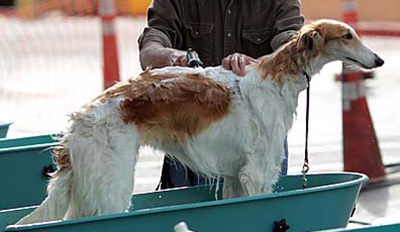
If bathing outside, in a garage or grooming room or an area where water shaken off a dog is not a problem, encourage your Borzoi to shake as much water as possible out of his coat. If indoors or in an area you do not want 'watered,' very gently squeeze or wring the hair on the body, legs and tail to remove excess water. DO NOT PULL THE HAIR. Blot or rub body coat, legs and tail with towels to further remove water before using a dryer. If you choose not to use a dryer, continue blotting and rubbing with dry towels and then allow the dog to be in a warm comfortable area where the coat can dry naturally.
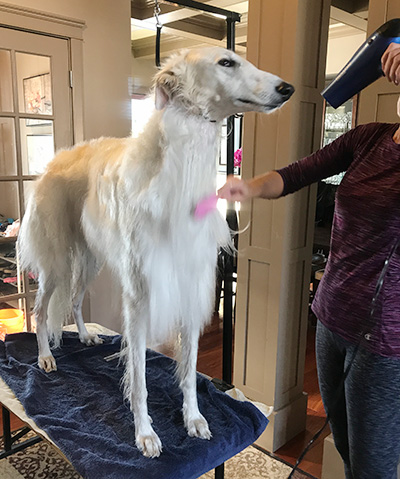
When using a dryer or blower to dry the coat, be careful of hair ends in areas of neck frills, legs, chest, pants and tail. The ends are fragile and knot up easily. Dry the hair next to the skin first and then out to the ends, using a pin brush to separate the hair and help fluff it. Avoid directing the stream of warm air onto a specific area of the dog for any period of time, if using a hot air dryer, since this can irritate the dog's skin. As you are drying, direct the hair in the direction you want it to lie. Fluff drying determines the overall appearance of the completed grooming job. When brushing, be careful not to apply too much pressure since the pins or bristles can scrape the skin causing irritation. Work out any mats that escaped the pre-bath brushing very gently in order to lose as little coat as possible. Do not direct the dryer nozzle too close to the skin and coat if you use a medium warm setting.
A bath in warm water will help loosen dead hair when the dog starts to blow (lose) his coat. Don't try to save coat. Dead hair in the coat mats readily. As soon as all the dead hair is removed, new coat growth is encouraged by regular, complete brushing.
Every dog is an individual and as such has individual needs when it comes to trimming. As stated and stressed above, too little trimming is better than too much. Consult several experienced Borzoi breeders or exhibitors if you have questions or would like demonstrations of proper grooming methods. Most will be happy to help you. You will get a variety of opinions on certain points. Often you will find the answer to your questions of 'why?' certain things are done will affect your final decision on just what is right for your Borzoi.
All Borzoi considered for conformation showing should be leash trained. Since many excellent books are available on basic training you are advised to consult them or an experienced trainer. Check your area for all-breed kennel clubs offering show handling classes.
The Borzoi and its owner should be familiar with basic ring procedures. Although these can vary from judge to judge, in general, all have the following facets. In most cases, the dogs are brought into the ring, when requested by the ring steward, and 'stacked' by their handlers. Many judges will make a preliminary walk down the line of dogs and then request that they be gaited around the ring. This may go on for one or more circuits of the ring until the judge calls for the dogs to be stopped. The handlers then stack their dogs again and the judge begins his examination of each individual dog. After completing his hands-on examination of a dog, the judge will then instruct the handler, giving directions on how to move the dog. Usually this entails the dog being moved down, across and back to the judge, sometimes followed by the dog being taking straight away from and back to the judge. The best advice is to be alert to the judge's instructions. If is often useful to watch the judge do other breeds before you go into the ring to get an idea of his ring procedure.
Stacking for the show ring is done from the dog's right side. A Borzoi is normally stacked by placing his forelegs so that when viewed from the front the legs form a straight line from the shoulder to the foot. Viewed from the side, the forelegs should be perpendicular to the ground. When stacking the dog from above, a guide to see if the dog's front is correctly set is to envision dropping a straight line from the highest point of the withers to the rear pad of the front foot. Some dogs rock back so that the front legs are at an angle. You can work at correcting this by moving in front of the dog and offering a tiny treat as bait to get his attention. Typically, the dog will relax and shift his weight forward straightening out his legs.
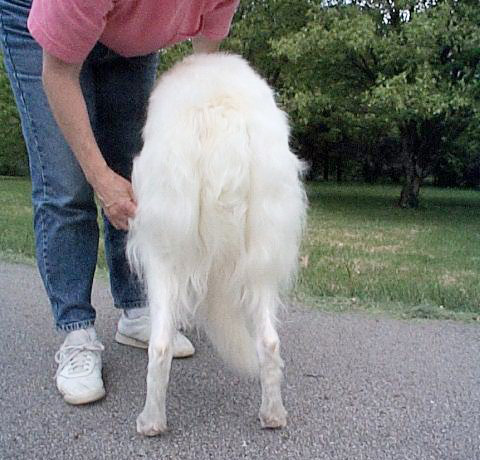
The hind legs are set so that the hocks are perpendicular to the ground when viewed from the side or the rear. Avoid stretching the rear legs back too far as this will flatten the topline and decrease the angulation of the stifle. Since many people stack from above the dog, a 'rule of thumb' is that a straight line dropped from the highest point of the dog's hip would hit the ground directly in front of the dog's rear foot on that side. Proper width of the rear can be observed if when you stand in front of the dog and look directly back you can just see each rear foot outside of each front foot.
The examination of a dog's bite and dentition is a part of judging. The judge will either do this himself/herself or request that the handler show him/her the bite. In any case, be certain that your dog is at ease with either you or a stranger (the judge) examining his mouth and teeth. Practice this so if or when you are asked to show the bite you do not fuss and fumble.
The Borzoi's gait is evaluated at a trot. Individual dogs each have a speed at which they are most comfortable moving and that best shows off their movement. A handler's job is to show the dog to its best advantage, not win a race around the ring. Try not to impede other dogs by either moving too slow or tail-gaiting the dog ahead of you with excessive speed. Be sure to "warm up" your dog prior to entering the ring. Find a place out of the way to do this, not the aisles around the ring area. This warm-up will reduce stiffness from crating or inactivity from just standing or lying around and will help relax you and your Borzoi.
Some local clubs have handling classes. If you are in an area where you have an opportunity to take advantage of one, do so. If not, then try and find someone to "play" judge. Since you can't always tell what your dog looks like moving from the side, coming towards or going away from someone, ask your "judge" or trainer how the dog looks moving in those ways. You might also have someone else move your dog while you evaluate the movement or consider using a video camera to tape you and your Borzoi going through your paces. Vary the speed at which you move your dog to try and find the one or ones that best show your dog's side movement and gait coming and going. These ideal speeds may be different and you and your dog should adjust them as needed. Practice gaiting your dog.
A judge at an American Kennel Club conformation show has about 2 minutes to examine and evaluate each dog. As a handler, you want to show your Borzoi at its best. Inadequate or poor handling can cost a dog its chance for the points. Practice can help you and your dog become a competitive team. Handling a dog to his points, and perhaps its championship, is a personally rewarding experience for you as a handler, but it has the added benefit of giving you a closer relationship with your Borzoi.
The sport of showing dog is competitive. It is one of the few where an amateur and a professional compete head-to-head on a regular basis. Direct monetary awards at shows are non-existent to very small. However, the potential economic impact to the owner or handler of a winning dog for stud fees, or a winning bitch for her offspring or for future clients for a handler, can be affected by an animal's show career.
Good sportsmanship is essential. While in the ring, concentrate on showing your dog to the best of your and his or her ability. The judge should be thanked for whatever ribbon he or she may award you. Before or after competing, or when observing other classes or breeds, keep you comments either silent or discreet. If you feel that you are justified making a complaint or protest, do so to the show superintendent or show secretary.
It is important to be a "gracious winner" as well as a "good sport." Congratulations to the winners are always appreciated.
Unfortunately, judges are human. They can have the same biases that any Borzoi fancier can have towards Borzoi of a certain type, color, movement style, etc. Give a judge more than one show before you form an opinion of his/her judging. Watch the judge evaluate other Borzoi or other breeds. Evaluate what the judge puts up for his/her selections. Are the judge's choices consistent on the type? What common qualities do the placed dogs have? Can you observe a similarity in the judge’s selection? How does one judge's placements compare with another's of the same or similar dogs? Always remember when you make an assessment that the judge has one advantage over you: he/she can examine the entered Borzoi hands on. Unless you have been able to "lay hands on" all of the entries, examine bites, etc., maybe the judge has found something of which you are unaware.
Finally, evaluate your Borzoi honestly and critically. Kennel blindness to the qualities of your dog is unfair to both you and your Borzoi. Is your dog always shown in competitive condition with other exhibits? Does your handling cost your dog placements? If after a number of shows, you are sure you are grooming and handling acceptably well, and your Borzoi has shown its heart out for you and for some reason the two of you as a team are not competitive, remember that not every dog is a show dog. Evaluate your alternatives. Find out what other knowledgeable exhibitors or breeders think about your handling and your dog. Sometimes you may experience runs of bad ring luck or really stiff competition from a dog which hits a hot streak.
Borzoi are intelligent, loving companions. This is their primary purpose in life. There are many other activities you and your Borzoi can participate in such as obedience, agility and coursing.
May good fortune and the best of luck be with you and your Borzoi in all of your shows.
American Kennel Club, The Complete Dog Book.
American Kennel Club, Rules Applying to Dog Shows.
Groshans, Lorraine, 1981: The Complete Borzoi, Howell Book House, Inc., New York, New York.
Contact the American Kennel Club at 5580 Centerview Drive, Raleigh NC 27606-3390 or online at http://www.akc.org/.
Revised 2014, Phyllis M. Potter.